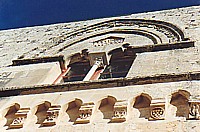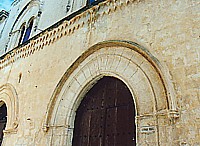
cortile of the palazzo falzon ("norman house")
 |
The Palazzo Santa Sofia is the oldest existing building in Mdina. The palace had a siqifah leading into a courtyard (now a narrow street), dividing the building into two parts. The doorway to the house was under this passageway. The oldest part of the exterior wall contains a square-headed window surrounded by a moulding which carries the date 1233. The figures might be a counterfeit, but it could also be the date when the house was first built. |
| palazzo santa sofia |
Originally the palazzo was a one-storey building with a central courtyard. There are still some remains of a drip-mould, which was decorated with the typical acanthus leaves that can also be found at Bir Miftuh. This is probably a feature influenced by Norman Sicily. Another decorative element is the string-course of inverted triangles with pendent blobs, which have the shape of small spherical balls. They used to mark the blank masonry face on the top of the exterior walls before the first floor was added.
|
The Palazzo Gatto Murina belonged to Francesco Gatto and was also altered throughout the centuries. At the beginning of the eighteenth century the building was turned back to front and received a Baroque main facade. The first floor of the original facade was probably built in the first half of the fifteenth century and is much more sophisticated in its design than the earlier built ground floor. The original entrance was probably an arched doorway with an ornate drip-mould surrounding the voussoir stones. |
 |
|
window of the palazzo gatto murina |
The facade is decorated with a string-course of miniature blind arcading, which runs between the two floors. It contains various motifs, like shields with the arms of the Gatto Murina family, leaf and floral as well as geometric patterns. Above the consoles, which support the small pointed arches, there are two fine two-light windows. These windows can be found on many medieval houses. The Gatto Murina windows are the earliest surviving ones and are similar to some Sicilian two-light windows. The drip-mould above the windows form on both ends a pair of rosettes, and it ends on a moulded projecting ledge, which has the form of a narrow, truncated cornice. It is similar to the drip-moulds that can be found on the doorways of the medieval Maltese churches.
 |
The Palazzo Falzon, popularly known as the ‘Norman House’, was remodeled in the early sixteenth century by the Knights of St. John. Originally it was larger in ground plan, and it used to be - like the Palazzo Santa Sofia - a one-storey high house with a courtyard. This courtyard was planned on the model of a Sicilian cortile at the beginning of the twentieth century. The house had probably a siqifah leading to the courtyard.The ground floor also underwent some modifications. |
| front facade of palazzo falzon |
Its facade contains small slit windows and two doorways. The doorway on the left was probably the entrance to a stable and was totally modified in the early twentieth century. The main doorway was remodeled by the Knights. The two-light windows on the first floor might have been made before 1530. A string-course consisting of two tiers of inverted triangles marks the division of the ground and the first floor. At roof level one can find a single serrated frieze of the same design.
 |
 |
|
| two-light window of palazzo falzon |
two-light window in mdina | |
|
The two-light windows represent the hallmarks of medieval architecture in Malta. They can also be found in Sicily. The Triq Santa Sofia in Mdina has a two-light window from the late fifteenth or early sixteenth century. It was decorated withend rosettes and has small consoles carrying the sill. A feature that is typical for Maltese architecture is the so-called “Melitan edge-moulding”. It serves as a softening device for hard angles of buildings and consists of a slender shaft with cushioning caps and bases, which are thrust into bold reliefs by shallow grooves on both sides. The problem with these windows is that due to considerable modifications their original design is often not visible anymore. |
 |
|
two-light window in mdina |
|
|
|